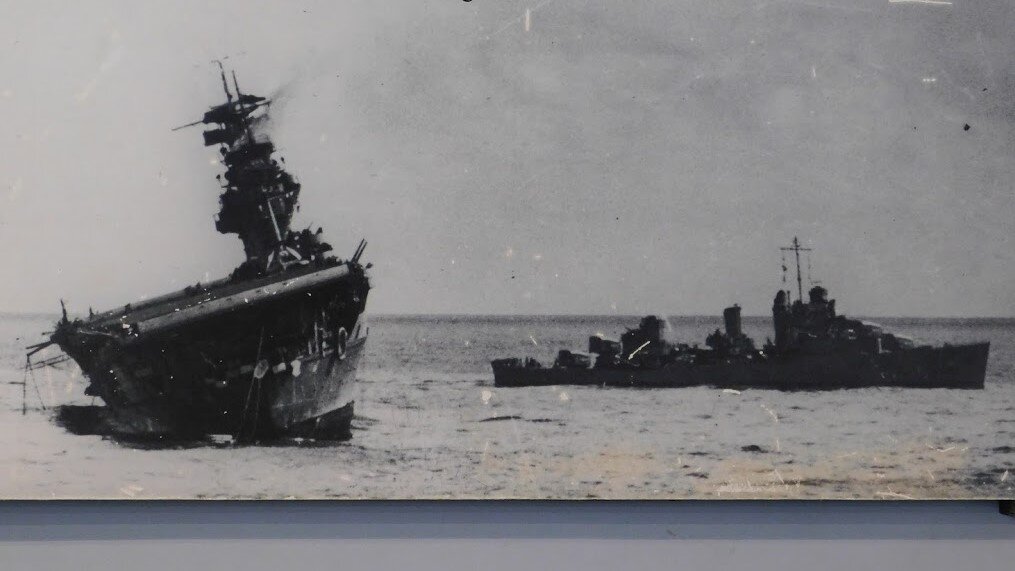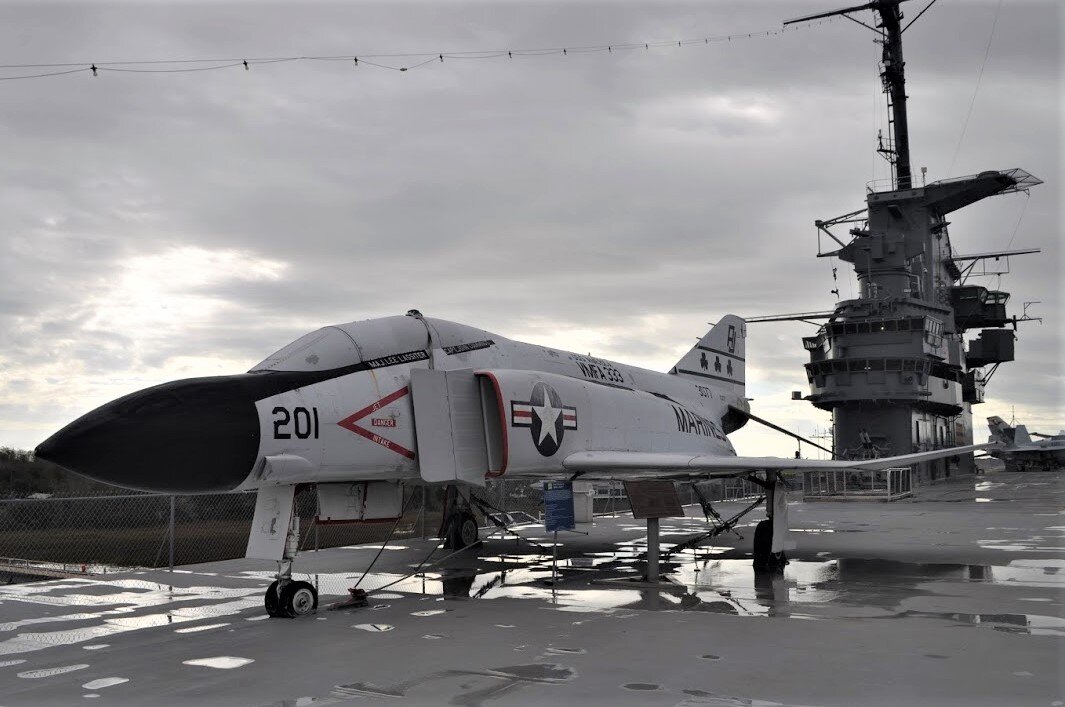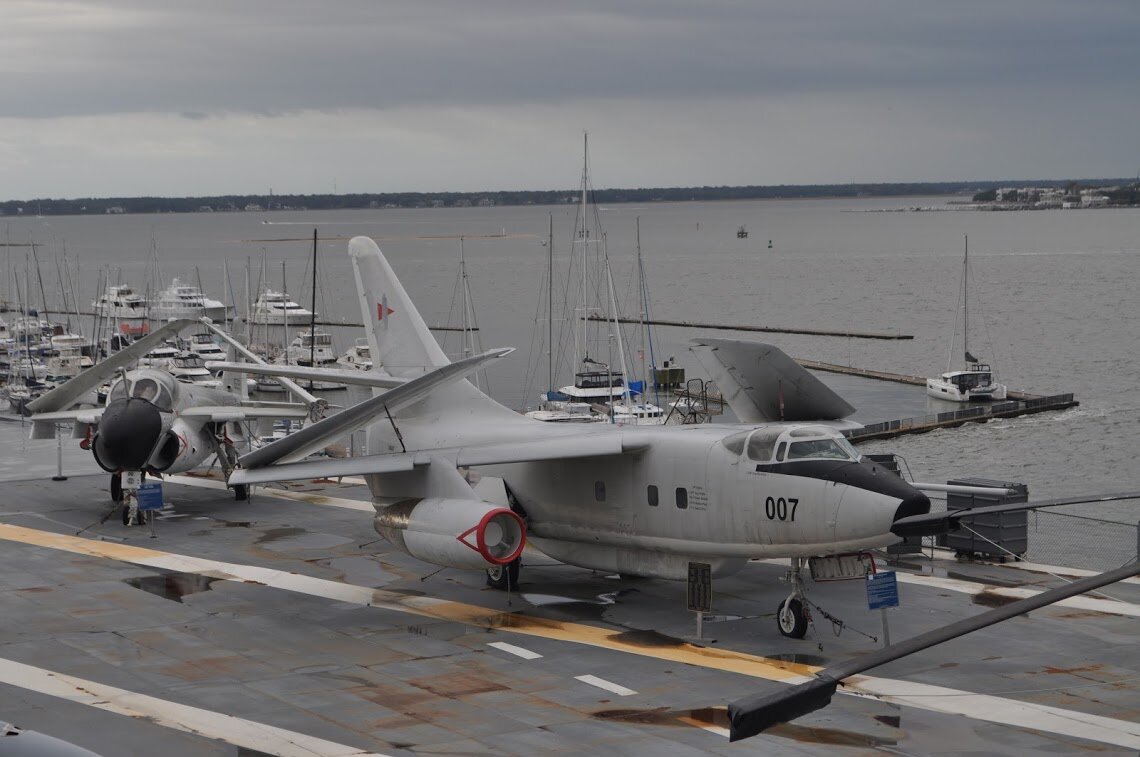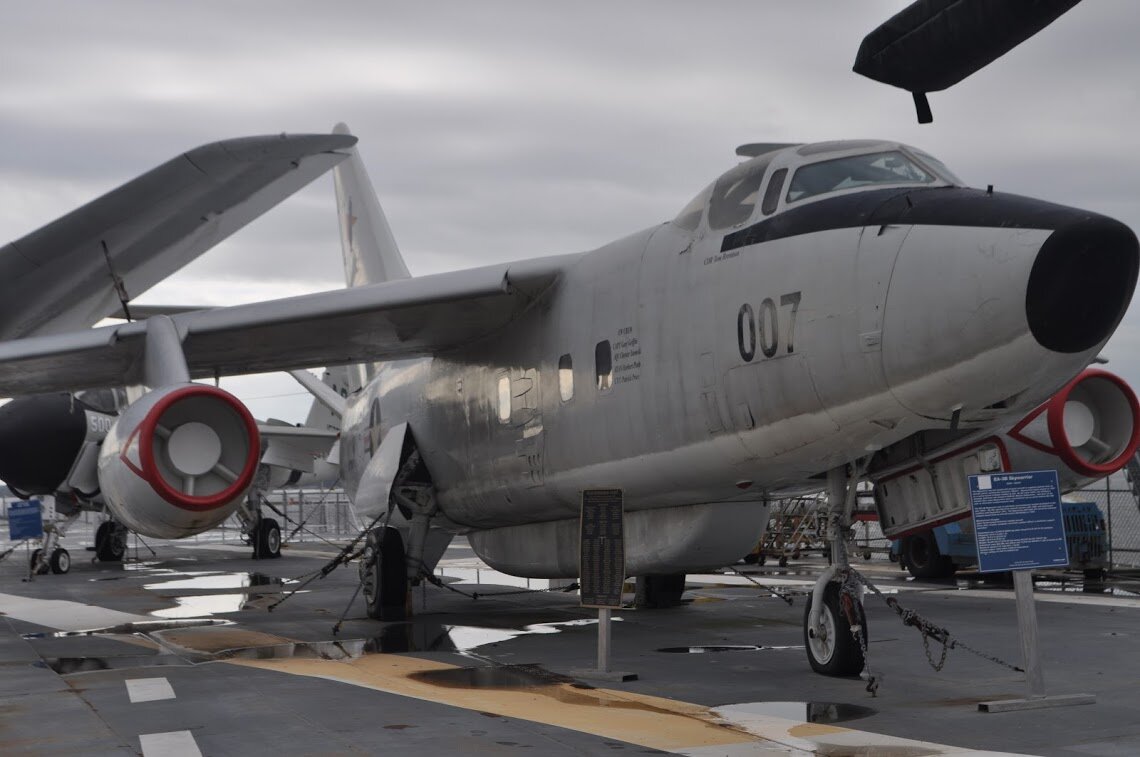Issue 21 USS Yorktown in Charleston South Carolina. March, 2021
SUBSCRIBE

—————————————————————————————————————————————-
On May 30, 1942, after hasty repairs following the Battle of the Coral Sea, the USS Yorktown (CV-5) set sail from Pearl Harbor. Intelligence had indicated that there was an imminent threat to the Midway Atoll. The Yorktown was to join up with the carriers Enterprise and Hornet in an attempt to surprise the Japanese and, on June 3, patrols spotted the enemy fleet. Planes were launched from all three carriers, and a major dog-fight took place 20 miles from the Yorktown. Japanese planes eventually broke through and scored several direct hits, heavily damaging and disabling the Yorktown. By the end of the day, she was listing and the order was given to abandon ship. The following day, a large contingent returned to the Yorktown and began evaluating the damage. Pumps were started and all unnecessary items were pushed overboard. The crews worked all day and were in the process of beginning a tow back to Hawaii when a Japanese submarine slipped through the defenses and scored hits with two torpedos. Most of the crew onboard were saved, but on the following day, the Yorktown sank. By this time, the Battle of Midway was over and the US had scored what has been called one of the most decisive victories in naval history.

Launched in 1936, The USS Yorktown was one of the first carriers built from the keel up as an aircraft carrier. By the time of the battle of Midway, a new, larger class of carriers was under construction. One of these new Essex class carriers, the Bon Homme Richard, was partially completed and it was decided to re-name it the Yorktown, to honor the service of the ship and those lost at Midway. That second Yorktown, CV-10, served in the Navy from 1943 to 1970 and is now an aviation museum near Charleston, South Carolina.
The USS Yorktown is a part of Patriot’s Point Naval and Maritime Museum. The complex also has a destroyer, a submarine, and other items on display. This blog, however, will concentrate on the aviation museum aboard the Yorktown.
The museum is essentially divided into two parts: The carrier deck, which has Vietnam era aircraft on display, and the hangar deck, which centers on WW-II aircraft and exhibits. It is a large museum, with many aircraft, so we will cover it in two parts. Let’s start topside and visit the hangar deck next month.

There were 24 Essex class carriers built between 1941 and 1950, and most of them were decommissioned in the late 1960s to the mid-1970s. The Yorktown was decommissioned in 1970, just before my time in the Navy, but I have landings on two other Essex class carriers: the Lexington (in the T-28C and the TS-2A) and the Intrepid (in the C-1A). The Intrepid is now a museum in New York City and the Lexington is a museum in Corpus Christi, TX; both are likely future blogs in this series.
Today, if you go aboard an aircraft carrier, you will see many F-18s and a few support planes, such as the E-2 Hawkeye. Interesting, of course, but limited in variety. During the Vietnam era there were many more types of aircraft aboard carriers, and most of those types are displayed on the deck of the Yorktown.
The Yorktown is classified as a CV, meaning carrier, fixed wing aircraft. There are several additional designations such as- CVN, for nuclear powered carrier (all active carriers today are CVNs), CVA for attack carrier, and CVS for anti-submarine carrier. The Yorktown was designated a CVA until September 1957, when she was reclassified as a CVS. The difference in classification mainly affected the Yorktown’s mission, and the types of squadrons, and planes, that would deploy on a cruise.

Prominent on deck is this Douglas A-3 Skywarrior. Designed as a strategic nuclear bomber, the A-3 is the largest carrier-based aircraft ever built. Nicknamed the “Whale”, the A-3 first flew in 1952 and wasn’t retired until 1991. By the 1960s, Naval nuclear strategy was focused on submarines and the A-3 found new roles as an airborne tanker as well as for electronic reconnaissance capability. The version on display here is an EA-3B. In the electronic intelligence role the EA-3 carried a crew of seven and had a range of almost 3,000 miles. Douglas built almost 300 A-3s as well as almost 300 versions for the Air Force (the B-66 Destroyer). This particular EA-3 was previously displayed in front of the BOQ in Rota Spain, which is where I first saw it. It had served in Rota as part of Fleet Air Reconnaissance Squadron 2 (VQ-2).

The Sikorsky SH-3 Sea King first flew in 1959 and had a long and varied service history. Built for anti-submarine warfare (ASW), it served in that role until the Navy retired it in 2006 and many Sea Kings are still in service in navies around the world. A version of the Sea King, the VH-3D, has served as the presidential helicopter, Marine One. for many years. Very appropriately displayed on a carrier deck, the SH-3 was commonly used as a “plane guard” during carrier operations. With an H-3 airborne at all times, any plane, or pilot, that would wind up in the water would receive immediate assistance from the helo and its on-board divers. The SH-3G (BuNo 149934) on display served with HS-1 from 1980-1994.

The Vought F-8 Crusader served with active-duty squadrons from 1957 until 1987 and with reserve squadrons until 1991. The Crusader aboard the Yorktown is BuNo 146939, which was built as an F8U-2 and later converted to an F-8K. A very distinctive feature of the F-8 is its variable-incidence wing, which tilts up 7 degrees. This gave the F-8 a greater angle of attack on take-off and landing, without reducing forward visibility.

This photo was taken in 1972, before colorful squadron insignias were removed from all Navy planes, leaving the drab grey markings of today. The missile attached just below the wing is a sidewinder.

Similar in appearance to the F-8, the A-7 was designed by Vought using the F-8 as a starting point. Displayed in the colors of VA-46, this A-7E Corsair II (BuNo 159291) served with a number of Navy and Marine squadrons from 1978 until its retirement in 1991.
Three aircraft on the Yorktown flight deck, the S-3, the F-14, and the F-18, are from the post-Vietnam era, bringing the Navy inventory on display on the Yorktown up-to-date through the end of the 20th Century.

The Lockheed S-3 Viking was built as a replacement for the Grumman S-2 Tracker which served in the Anti-submarine (ASW) role for 30 years. Introduced in 1974, the Viking served as a carrier based ASW aircraft for over 40 years, being retired in 2016. Like the S-2, the S-3 had a crew of four: Pilot and Co-pilot/Tactical Coordinator (COTAC) up front and Tactical Coordinator (TACCO) and Sensor Operator (SENSO) in the back. The Viking on display here, BuNo 159731, was built as an S-3A and, like most S-3s, was later converted to an S-3B. The S-3B conversion in the mid 1980s added an airborne tanker role as well as anti-ship capability with Harpoon missiles. This S-3 last served with VS-41 in San Diego and was retired in 2006.

First flown in 1978, the supersonic McDonnell Douglas F/A-18 Hornet was designed to serve in a fighter or attack role (hence the F/A designation). The versatility of the Hornet is the reason there is only one major type on carriers today; the F-18 can fill the role of most of the types on the deck of the Yorktown. One of the reasons for the great success of the Hornet is its General Electric F404 engines, which are reliable and easy to maintain, while delivering excellent performance. The Hornet is built in single-seat and two-seat versions, depending on the required role. The Hornet on display on the Yorktown, BuNo 162435, is a single seat A model that served with a number of squadrons from 1985 to 2007, ending its active service with the Marine Corps in VMFA-142.
Introduced in 1999, the Super Hornet is essentially a new plane that kept the F/A-18 designation (possibly to simplify the funding process). The Super Hornet also has a single seat (F/A-18E) and a two seat (F/A-18F) version. Although visually similar, the Super Hornet is four feet longer, with a four foot greater wing span, and a 14,000 pound higher maximum takeoff weight. Boeing purchased McDonnell Douglas in 1997, which makes the Super Hornet a Boeing F/A-18. After flying the Hornet for over 30 years, the Blue Angels recently transitioned to the Super Hornet.

After WW-II the Yorktown, like many ships, was placed in reserve status and in 1947 she was decommissioned. By 1952, the Yorktown underwent major renovation work and was returned to active duty in 1953. Like all carriers of WW-II, The Yorktown was originally built with a straight deck. The renovation in the early 1950s was undergone to support jet operations and included major strengthening of the deck and the addition of more powerful catapults. There were also many additions of armaments and other capabilities, increasing the ship’s displacement by 20%. After all the modifications, however, the Yorktown remained a straight-deck carrier. The Yorktown made several Pacific cruises until 1955, when she was once again put into reserve at Puget Sound Naval shipyard in Bremerton, Washington. During this time, she again underwent major modifications, most notably, the addition of an angled flight deck. Invented by Dennis Campbell of the Royal Navy, the angled carrier deck greatly increased the capability and safety of carrier operations and all subsequent carriers have been designed from the start with an angled deck.
The Yorktown continued Pacific operations throughout the 1960s and was involved in combat operations during the Vietnam War. We will look at other aspects of the Yorktown’s storied history in next month’s issue.
On June 27, 1970, Yorktown was decommissioned at Philadelphia, and placed in storage there for the next four years. In 1974, the Yorktown was approved to be donated to Patriot’s Point in South Carolina and was towed there in June, 1975. On October 13, 1975, the 200th anniversary of the U.S. Navy, the museum was formally dedicated.

The Yorktown has been maintained in excellent original condition from the 1960s and many interior areas of the ship are available for visitors to explore. On deck, most of the Yorktown’s Island is open to visitors. The Island houses the Bridge, Primary Flight Control (Pri-fly) and the Flag Bridge. Pri-fly is basically the control tower of the ship and is manned by the Air Boss. You can see Pri-fly on the rear of the Island and the Bridge on the front of the Island with the Flag Bridge below it.
As a Carrier Onboard Delivery (COD) pilot, I only spent 90 minutes at a time on an aircraft carrier, so I asked my friend CJ, from high school, to give us an overview of the command structure of a carrier. In 1972, CJ made a Vietnam cruise on the Ticonderoga, a sister ship of the Yorktown, flying S-2s with VS-21. Following that, his squadron was the first to transition to the S-3A. Unusual for a West Coast squadron, VS-21 was selected for a Mediterranean Cruise on the Kennedy, so that the S-3 and its crews could get operational experience tracking Russian subs. CJ was on-board the JFK in late 1975 when the Guided Missile Cruiser Belknap (CG-26) collided with it, and he spent a long night helping fight the major fire on the Belknap. We may ask him about that experience in a later blog. Here’s CJ’s response about the command structure on carriers-
“The Captain of an aircraft carrier (who also holds the rank of captain) is always an experienced Naval Aviator, with extensive ship handling experience. The Captain has ultimate authority over all ship functions and personnel.
Carriers normally deploy for six to seven months, and around nine squadrons of aircraft will be assigned for the cruise. The person responsible for command of the deployed squadrons is the Carrier Air Group Commander (CAG). The CAG also holds the rank of captain and is responsible for the readiness of the Air Wing. The CAG does not fall directly under the command of the ship’s Captain, rather they are co-commanders who report to the Strike Group Commander. The Strike Group Commander is an Admiral who has responsibility for all ships in the Strike Group.
Each of the Squadron Commanders on board report directly to the CAG, and they will routinely assign personal to ship’s company departments to supplement manpower and gain knowledge and expertise in shipboard operations. This includes providing Landing Signal Officers (LSOs) to the Ops department, to assist with the safe and timely landing of all aircraft.
Most important to the Air Wing is the Air Boss (a commander). This is a ship’s company position and the Air Boss oversees all flight operations from Pri-fly.”
Thanks CJ!

The spaces throughout the ship that are open to the public are all kept in the condition they were in when the Yorktown was operational. Here we see the navigation area, behind the Bridge. Many original artifacts are maintained in place, and most of the spaces are open to just wander through, the same areas that ship’s company personnel occupied for almost 30 years of the Yorktown’s operations.

All of the fittings on the Bridge remain as they were in 1970- you can even sit in the captain’s chair.

From the Bridge, you get a nice view of the two aircraft that are spotted roughly on catapults three and four: An E-1B and an F-4J.

The McDonnell Douglas F-4 Phantom II was produced from 1958 through 1981, with over 5,000 built. Flown by both the US Air Force and US Navy, the F-4 was also operated by numerous other countries, and several countries still operate the type today.

The Grumman E-1B Tracer was developed from the C-1, itself a derivative of the S-2. Better known as “Willie Fudd” (it was originally designated the WF-2) or the “Stoof with a Roof” (from the S-2F), the E-1 was the first carrier-based early warning aircraft. The actual catapult gear is not in place on the Yorktown (for safety reasons, I’m sure), but if the E-1 was ready for a cat shot, the nose wheel would be raised about eight inches, and the bridle would be attached behind the nose wheel.

At the same time that the bridle is attached to the forward part of the aircraft, a hold-back fitting is inserted in the rear. The purpose of the hold-back is to allow the catapult harness to be moved forward and tensioned (lifting the nose wheel), while keeping the aircraft from moving forward.


When the catapult is fired, the hold-back snaps in two, releasing the aircraft. The upper half might fall out or stay on the aircraft. Above are a couple of fittings after cat shots. The fittings were saved by my good friend, and COD pilot, Pete Abiouness (better known a “Turkey Pete”).
Getting E-1 and C-1 aircraft positioned on the catapult can be tricky. The nose wheel on these aircraft is free-wheeling and when you approach the launch point, the nose wheel has to go over the top of the shuttle (where the harness attaches to the catapult), and then stop pretty quickly. It is difficult, but important, to keep the nose wheel straight so the plane is properly lined up. A slightly off center nose can lead to a weaving motion during the cat shot- not a comfortable feeling! If the plane is co*cked too much after crossing the shuttle, the only remedy is to have a half dozen or so yellow shirts push the plane backwards over the shuttle, to try again- not a pretty sight! The problem does not happen on CVS carriers, with S-2s onboard- they have tow bars that help guide the nose-wheel.

Towards the aft of the flight deck is this S-2E Tracker (better known as a “Stoof”), BuNo 151627. S-2s were the main type of aircraft onboard the Yorktown from 1957-1970. Introduced to the fleet in 1954, the S-2 was the first aircraft to be built specifically for anti-submarine warfare. Over 1,200 S-2s were built and they served in the US Navy until 1976. They also served in the military of a number of countries, and many continue on today in various civilian roles, including firefighting. As a TS-2A, the Tracker served as an advanced multi-engine trainer for many years.
Three other aircraft round out the display on the deck of the Yorktown: An F-14, an A-4, and an A-6, each type having a long and successful Naval history.

This Grumman F-14 Tomcat, BuNo 159025, served in a number of Navy squadrons from 1974-1994.

Almost 3,000 Douglas A-4 Skyhawks were built between 1954 and 1979 and the A-4 played a key role for the Navy during the Vietnam War. A two seat version of the F-4, the TA-4F, was the Navy’s advanced jet trainer for many years. The A-4 on display, BuNo 149623, is a C model.

This Grumman A-6E Intruder, BuNo 152599, served with both Navy and Marine squadrons from 1972-1994.
—————————————————————————————————————————
Located near Charleston, a great city to visit, Patriot’s Point is an excellent destination for a family visit. Be sure to give yourself plenty of time to explore all the exhibits, although it would be easy to spend an entire day on the Yorktown. Join us next month to learn about all the interesting aircraft on the Yorktown’s hangar deck and other areas below deck.
————————————————————————————————————————
Many thanks to Lenore Taylor of the National Naval Aviation Museum and Captain Thom Ford of the USS Yorktown Foundation for their assistance with research for this blog.
———————————————————————————————————————-
Special note
During WW-II, the Navy used NAS Glenview, near Chicago, for numerous phases of training, including carrier qualifications. As a result, 130 aircraft were lost in Lake Michigan. Starting in the 1980s, an effort was undertaken to find and catalog these planes and, eventually, dozens of aircraft were recovered from the water. The Military Aviation Museum in Virginia has recently acquired one of these aircraft, a Douglas SBD Dauntless. They have placed it on display for the month of March, before it undergoes a full restoration to flying condition.

I have previously mentioned the excellent webinar series put on by the Military Aviation Museum in Virginia Beach and a special edition of that series, The Rescue of the Once Lost World War II Navy Aircraft from Lake Michigan was an excellent presentation. Click here to view the presentation-
https://www.youtube.com/watch?v=35UbX-EdnZ0
The process of a full restoration like this is a long one, but we will give regular updates along the way.
———————————————————————————————————————————
subscribe
past issues
contact us
--------------------------------------------------------------------
To learn about what to do in the local area, museum hours and costs as well as books to read and other interesting odds and ends, keep reading! At the end you will find a photo gallery of the entire museum.
PLANNING YOUR VISIT
Patriots Point Naval & Maritime Museum is open every day aside from Christmas Day. Current operating hours are 9 AM to 6:30 PM. The last tickets are sold at 5 P.M.
Admission includes:
USS YORKTOWN, Aircraft Carrier
USS LAFFEY, Destroyer
USS CLAMAGORE, Submarine
3 Acre Vietnam Experience
Medal of Honor Museum
Adults : $24
Veterans/ First Responders (ID Required) : $21
Active Duty/Retired Military (ID Required): $19
Seniors (62+): $19
Children (6-11): $16
Children Under 6: Free
FLYING IN
Charleston International Airport (CHS) and Charleston Executive (JZI) are both about 25 minutes from Patriot’s Point. Each are full-service airports.
LOCAL ATTRACTIONS
Charleston, SC is a great place to visit for a wide-variety of Southern charm, historic sites, outdoor adventure and many other activities. https://charleston.com/
WHERE TO EAT
Museum Staff recommended Water’s Edge Restaurant on Shrimp Boat Lane, just a few minutes away.
Reader Andy Brothers added this recommendation: Vickery’s Bar & Grill, a great casual spot which is also on Shrimp Boat Lane. Thanks Andy!
SUGGESTED READING
Any time I am researching Navy aircraft, I reach first for my copy of United States Navy Aircraft since 1911 by Gordon Swansborough & Perter M. Bowers. With photos, drawings and statistics, this great reference book covers virtually every aircraft (including blimps and gyrocopters) ever flown by the Navy and Marines. Originally published in 1968, my edition is from 1983. I don’t believe the book is still in print, but it is readily available through the usual sources. Besides a great reference tool, each two to three page entry has a variety of information and it is interesting to just pick up and read an entry or two at random.
MUSEUM WEBSITE
https://www.patriotspoint.org/
UP NEXT
USS Yorktown, Part 2: Below deck.
MUSEUMS ARE WHERE YOU FIND THEM
This segment is dedicated to finding interesting aviation artifacts that are in public view- but not in an aviation museum. If you see one send a photo!
While travelling recently in Colorado, my son Eric came across this Lockheed T-33A Shooting Star in a dramatic setting. It is located in Costilla County Veteran’s Park and the Memorial Stone has the names of Costilla County veterans who served their country.
Thanks Eric!


————————————————————————————————————————
PHOTO GALLERY
Click to enlarge
Issue 21, Copyright©2021, all rights reserved. Except where noted, all photos by the author
Tony Bruno



























